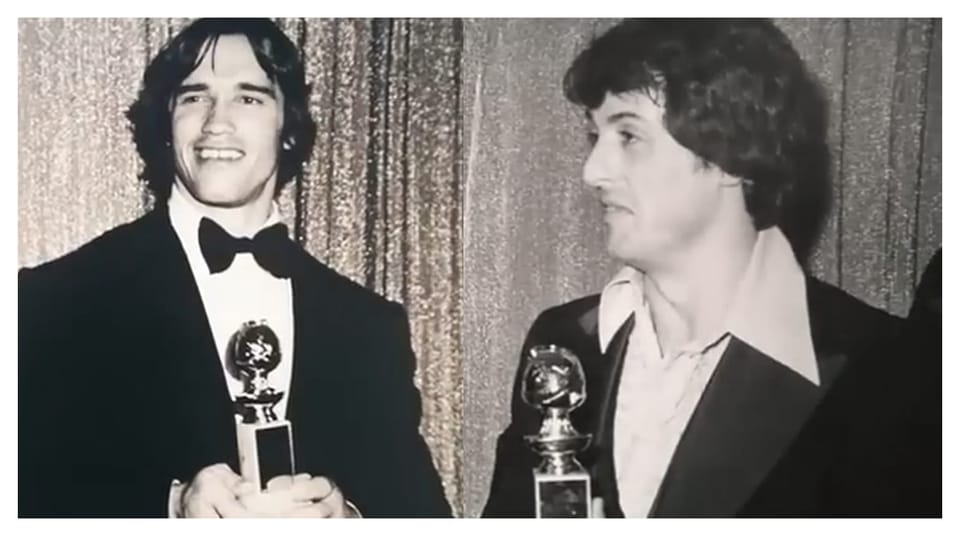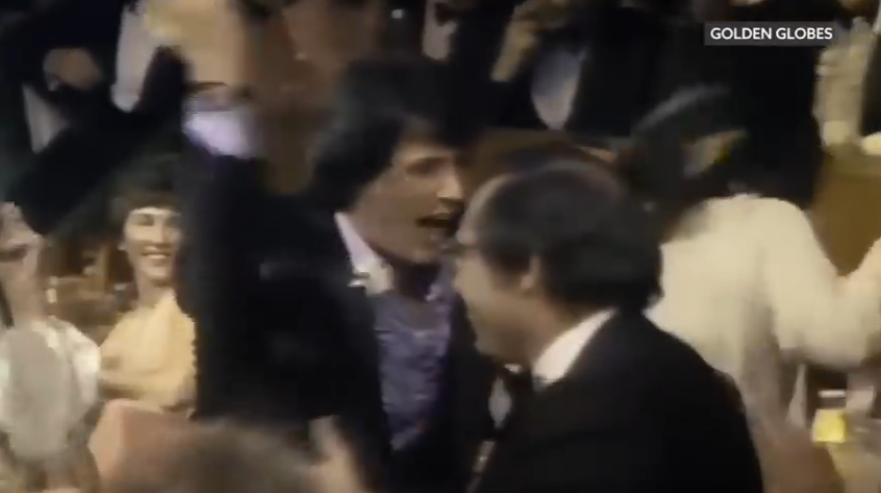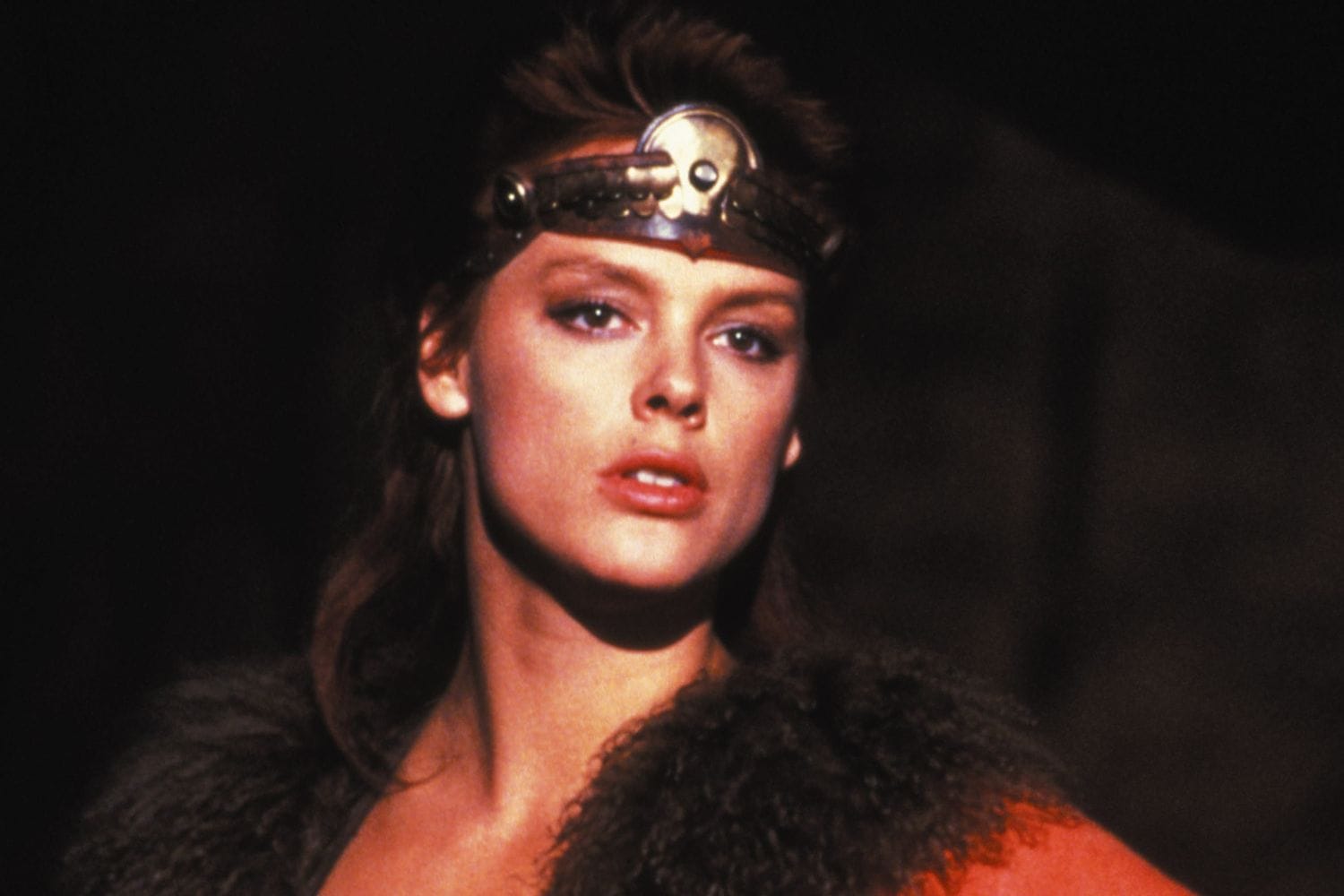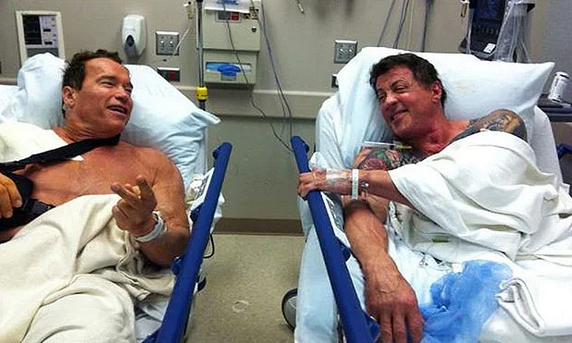Beef: Schwarzenegger v Stallone: Introduction

It began with flowers. On 29 January 1977, Sylvester Stallone was pitching up at the Beverly Hilton hotel at the ceremony for the 34th Golden Globes, waiting to be coronated as Hollywood’s hottest new star. His outta-nowhere blockbuster Rocky – released two months earlier, and sweeping all before it at the US box office – was up for six awards. Just 30, youthful pudge still filling out milkfed features, he had pulled out the big guns from his wardrobe: the vast wing collars of a frilled mauve shirt ushering in his big moment.
Then he saw Goliath was at his table. Two hundred and fifty pounds of Austrian prime cut, shoulders tapered down in a black tuxedo, a bowtie frivolous-looking on that huge body. And that gap-toothed grin. Arnold Schwarzenegger was accepting the New Star of the Year award, for a supporting role in the comedy-drama Stay Hungry. But the bodybuilder, four times Mr Universe and six times Mr Olympia, was also here to size up and psyche out the competition in his new chosen arena: cinema. As Rocky was passed up for gong after gong – Best Score, Best Screenplay … – the Austrian gloated at the Italian-American’s losing streak. “We weren’t getting this category, and then I lost Best Actor. And I’m going: Jesus, this is a nightmare,” Stallone later remembered.[1]
But, as in Rocky, the underdog finally pulled it out of the bag. When the winner for Best Motion Picture – Drama was announced, his number finally came up. Before he went up to collect the top prize, Stallone’s frustrations erupted: “I grabbed this giant bowl of flowers and heaved it in [Schwarzenegger’s] direction.” Sophia Loren, at their table, must have been agog. And so the gauntlet for modern showbusiness’s most pec-popping – and bitter – rivalry was thrown down not with a spray of Uzi bullets, but a flood of lilies and tulips.

After it later won three Oscars, including Best Picture, Rocky – into which Stallone had poured his personal frustration, humiliation and perseverance – turned him the world’s biggest movie star. By the mid-1980s, a glut of Balboa sequels and the incipient Rambo franchise also made him the highest paid. But Schwarzenegger was tailgating him relentlessly, as the pair vied to outdo each other with every successive action movie release and waged a PR war in the press. “They were both very competitive,” says Mario Kassar, founder of Carolco, the paradigm-busting company that produced films for both actors. “They always wanted to do better than the other – they were very conscious of their body and their stardom, the kinds of movie they were doing. Who got the most money, who got to kill more people on screen.”[2]
Literally and metaphorically, it was an arms race. The competition between the two men helped cast off the heavy-coated social consciousness and deeper characterisation of 70s action cinema, to revel in the bare-chested excesses of this bombastic, ultra-violent and often nationalistic genre in the 80s. As their paycheques pushed these films into the budgetary stratosphere, and one-time B-movies became blockbusters, everything on screen got bigger and more outrageous: the muscles, the militarism, the car chases, the explosions. Setting box-office records with this new mayhem, Stallone’s and Schwarzenegger’s celebrity received a steroid injection, at the apotheosis of Hollywood’s star system – which in turn boosted the next round of films.
Schwarzenegger fired the first shot of the war. Seemingly offended by Rambo: First Blood, Part II’s stonking box office performance in summer 1985, he unloaded on Stallone on the promotional run for Commando. “I’d be angry at hearing my name mentioned in the same breath as Stallone’s,” sneered the Austrian upstart.[3] A year later, he waded in even more brazenly in another interview: “If you're doing 120lb curls, he will say, I can do 130. He's obsessed, and that carries through in the way he dresses, how hard he tries to belong to a charity organisation. It's all Rocky, it doesn't come from, you know [Arnold points to his heart] … There's no love there. And people see that. You can fake your way through for a year, but for ten years, that's hard. I think that's the difference between him and me."
Even though he was far from the extrovert Schwarzenegger was, Stallone had no choice but to respond. “That’s something I’ll just have to ponder in private,” he told a journalist in mid-1988. “Whatever difficulties two people have shouldn’t be aired publicly, it should be taken care of privately.”[4] And that is what he did, launching a concerted campaign not to just to haul his rival down a peg, but to denotate a nuke under the stockade of Schwarzenegger’s public reputation. The two actors carried on slugging it out in their films and in the press until the end of the decade. The words of Commando co-star Dawn Rae Chong, commenting on a Delta Force vs Green Beret punch-up in that film, equally applied to the two stars: “I can’t believe this macho bullshit!”

At the heart of this steroidal spat was 6ft 1in of strapping, ice cream-coiffed glamour and Valhallan libido: the model and breakthrough actress Brigitte Nielsen, who starred with Schwarzenegger in 1985’s Conan spin-off Red Sonja and married Stallone shortly afterward. A woman who was a match for both of them in terms of ambition, but whose little-known part in their contretemps was steamrollered off the record in the interests of their careers and egos. According to who tells the tale, the victor emerges differently – though neither man finished alongside her. Nielsen is the Helen of Troy of this Hollywood mock epic, only with shoulderpads and an NDA agreement.
On the face of it, Stallone and Schwarzenegger seemed like opposing forces. In their cinematic personas: the hangdog loner vs the invulnerable destroyer. In their professional modus operandi: the control-freak creative powerhouse who dramatised his outsidership as his route to stardom, vs the easy-going bodybuilder, happily ceding to directors, slipping into Hollywood to the manor born. In their lives: the retiring Italian-American, surrounded by his Mafia-esque entourage vs the gregarious immigrant uniting cultures in the gym.
But as blockbuster villains like to say: we are not so different, you and I. Despite Stallone’s 10-year headstart in the business, he was only a year old than Schwarzenegger. Like Arnie, he started with little in life. Born in the Hell’s Kitchen ghetto of Lower East Side New York on 6 July 1946, Stallone was the son of nightclub dancer Jackie Labofish and wannabe lounge singer Frank Stallone Jr. Partially facially paralysed because of a forceps accident at birth, he also had rickets as a young child as his parents skimped on food to save money to escape the neighbourhood. Neglected by his mother, subjected to violent discipline by his father, “Love was not that forthcoming”, he later said.[5] But he metabolised this harsh upbringing into an indomitable will to self-improvement and, eventually, to break into Hollywood.
Schwarzenegger, born on 30 July 1947 in the Austrian village of Thal, was also the son of an inveterate disciplinarian: his father Gustav, the local police chief and former Nazi party member. With his mother Aurelia and older brother Meinhard, they lived amid dulcet natural beauty in this set of interconnected forest hamlets – but with no refrigerator or bathroom and the odd drunken beating from Gustav, perhaps inflicting his wartime trauma and humiliation on his family. But it didn’t cow the naturally lustig (cheerful or exuberant) young Schwarzenegger who, taking up the sceptically viewed sport of bodybuilding at a lakeside club, dreamed of fashioning himself into the images he saw on the cover of American muscle magazines. Every aspect of life over the Atlantic transfixed him: the skyscraper, the freeways, the Cadillacs, the dynamism and self-actualization so different from stagnant Austria. Finally, in 1968, invited by bodybuilding promoter Joe Weider, he made the move. He arrived in LA with just a crumpled plastic bag with a few personal effects and a gymbag: “I thought: finally I’m home.”[6]
Though Schwarzenegger now objects to the term “self-made man”, they were both self-actualising to a great degree; Stallone writing Rocky for himself to star in after years of struggle in acting’s lower echelons, Schwarzenegger willing himself into the limelight one rep at a time. The Italian-American’s early 1980s status as Hollywood bigwig masked his arrivisme. But he was simply a generation further on than the Austrian in being immigrant poster boys, living the dream. Maybe this fundamental similarity was what added extra spice to their rivalry: the coarse Mitteleuropean muscleman, hustling his way to the top, was all too redolent to Stallone of his desire for popularity – and its fragility.
Freud and Jung, those psychoanalytic frenemies, would surely have to plenty to say about this face-off, which inflated the vanity of small sibling differences through fame’s pitiless lens. The animosity prised open their protein-packed facades to expose true fallibilities: Schwarzenegger’s need for dominance and Stallone’s inferiority complex, which were inverted mirrors of each other. Achilles vs Hector, Federer vs Nadal, Blur vs Oasis … there’s something irresistible about an intense rivalry, caught in the clinch of the mythological and the intimate.
By the early 1990s, a truce was in force. The pair waltzed together arm-in-arm at a promotional event for Carolco Films, which produced the Rambo films and Total Recall, at Cannes in May 1990; just over a year later, they opened the first Planet Hollywood restaurant, in partnership with the new lightweight-model action hero Bruce Willis.

Forty years on, the pair appear to be the best of friends. Milking nostalgia for the 80s action meathead, Schwarzenegger appeared in three instalments of Stallone’s “geri-action” franchise The Expendables – and the pair finally co-starred together proper in 2013’s Escape Plan. They were photographed side-by-side in hospital beds in 2012 like Rocky and Apollo Creed, the crumbling hulks being scheduled for shoulder surgery one after the other. They laugh at their former sniping, with even the prickly Stallone admitting that his opponent got him good when he hoodwinked him into doing 1992 comedy Stop! Or My Mom Will Shoot; “one of the worst films in the entire solar system”,[7] as he later buried it. From a 21st century vantage point, their rivalry looks like a passing, regrettable yet retrospectively hilarious interlude of good old-fashioned toxic masculinity.
Both men would admit it all got a bit of hand. And in an instance of adversity-coming screenwriting gurus would approve of, that their epic face-off taught them a lesson or two. As the Austrian conceded in the acknowledgements to his recent self-help book Be Useful: “Sylvester Stallone inspired me with his unbelievable talent and became the rival I needed to fuel my drive for my rise to Hollywood, and then he became a dear friend whom I can call about anything.” In their brawny hands, the old clichés resonate like soft-rock power chords: the worst of times can turn out to have been the best of times, your nemesis to be your running buddy, and that the lessons learnt in the eye of adversity are the most life-changing of all.
From exclusive interviews with those closest to Stallone and Schwarzenegger, and who helped them shape their screen personas and build their fame, this is the story of the 80s’ most compelling screen rivalry and how it shaped the emerging action cinema. Which in turn fluffed the American ego; their battered pugilists, homicidal robots, arm-wrestling single dads and “Colonel John Matrix” supplying the brash decade with masculine role models able to ward off national post-Vietnam blues with a burst of Uzi fire.
And irrespective whether the two men really changed as result of their epic face-off, or whether or not there’s a single lesson to be had from any it, the all-important question stands: who won this bout? Who was the Mozart of the M-16 and who the special forces Salieri?
[1] Variety, https://www.youtube.com/watch?v=Ra9Y5QCKw5s
[2] Author interview
[3] News of the World, October 1985
[4] Us magazine, Wendy Leigh, June 1988
[5] Stallone: A Rocky Life, Frank Sanello, p15
[6] Arnold, Netflix series
[7] Ain’t It Cool News, 2006

Member discussion